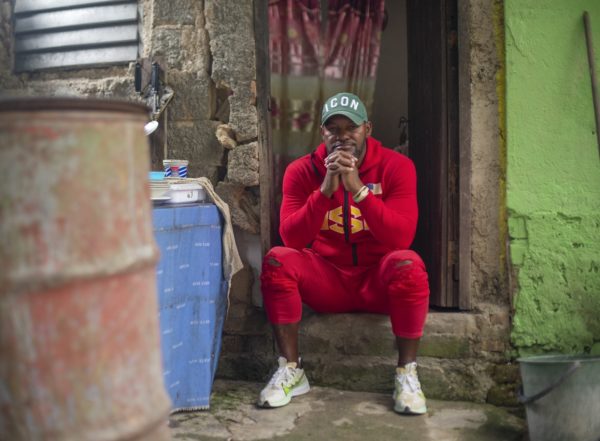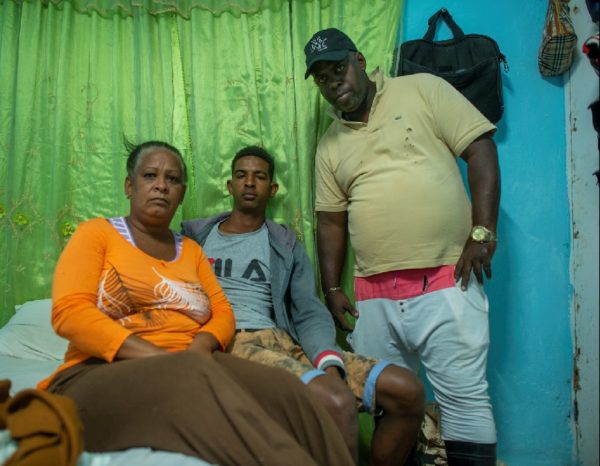Havana’s “La Guinera” Barrio: Punished after July 11th

By Darcy Borrero Batista
Photos: Werner Holt
HAVANA TIMES – On Tuesday January 25th, Emilio Roman Matos went to the Municipal Court in Havana’s 10 de Octubre neighborhood, for the fourth time in two weeks. He didn’t have the strength to go in, but from outside, he kept himself up to date on the trials of dozens of people who took to the streets to protest against the Cuban Government in July 2021. Three of these people are his children.
These three —Emiyoslan, Mackyani and Yosney— protested on the streets of La Guinera, a Havana neighborhood with a reputation of being “marginal”, where 96 of the 790 people in Cuba for taking part in the protests on July 11th and 12th, that is to say, 12 out of every 100 people arrested for protesting are La Guinera locals.

Emiyoslan is the youngest out of Emilio’s three children. The young man, who is now 18 years old, was arrested on July 13th, before reaching adulthood. He has been behind bars since this day, just like his sister Mackyani and his brother Yosney. The three of them form part of the 730 people that continue behind bars after the protests, according to the citizen-led initiative Justicia 11-J.
The 96 people prosecuted from La Guinera have been charged with sedition, the most serious crime protestors are being sentenced for, which can mean up to over 20 years in prison. In fact, this Havana neighborhood has the highest concentration of sedition charges in the country. Six out of every ten people prosecuted for this crime protested there, according to a count by Justicia 11-J.
However, trial records of La Guinera’s cases – where approximately 25,000 people live -, reflect weak allegations, full of contradictions and baseless evidence.

What do the records say?
The Public Prosecutor’s Office says that sedition charges against La Guinera residents are due to the “level of violence in vandalic acts that in a riot-like situation led to injuries and put the lives of civilians, public officials and law enforcement officers at risk, by attacking them with sharp, blunt and incendiary objects, seriously disturbing public order with the deliberate purpose of subverting rule of law.”
However, these same records state that in La Guinera police patrol cars weren’t attacked —unlike other parts of the country—, and the highly-criticized dollar stores weren’t vandalized, there was no looting or serious damage to property.
Furthermore, those charged with sedition include people who were only recording and live streaming events on Facebook, without taking part in any conflict with the police, as well as detainees who the Public Prosecutor’s Office is charging with sedition for the simple fact they were present in the crowd that prevented public order.
For example, 33-year-old Odet Hernandez Cruzata was taken to trial after the Public Prosecutor’s Office called for a 23-year-sentence for sedition charges. The Public Prosecutor’s Office proposed 20 years for her partner, 41-year-old Reinier Reynosa Cabrera, for the same crime. Both claim that they were only livestreaming the protest and weren’t taking part in violent acts.

The Public Prosecutor’s Office used Hernandez’s live stream as evidence, as well as possession and inspection of her cellphone, where they found six videos taken during the protest in La Guinera, on July 12th. Furthermore, the legal body has “record of the detainee Odet Hernandez Cruzata’s voice”, that allegedly proves she said “counter-revolutionary” slogans.
The accusations also try to connect protestors with the opposition in exile, without them having any ties. This happened in singer, musical arranger, and composer Wilmer Moreno Suarez’s case, for example.
Moreno Suarez received a sum of 240 USD per month from a Cuban citizen living in the US, Rolando Regata, via Odisea Studios which he uses to promote his work. As Regata had written to Moreno Suarez during the days of protest, the Public Prosecutor’s Office says that he became an instrument for the opposition movement abroad. Moreno Suarez’s trial is awaiting a sentence and the Public Prosecutor’s Office is after a 25-year-prison sentence for him.
During an interview, Regata said that he didn’t even know he was mentioned in a court document in Cuba. He explained that he is a musician and has “nothing to do” with politics. “I’ve been living in the US since I was 12 years old. The money I sent him was to help him out and for our musical collaborations. At no point did I pay him to go out and protest. Plus, if I was a member of the opposition, would I only send him 240 USD? That doesn’t make any sense,” he explained from Fort Myers, Florida, where he lives.
Only three of those charged in La Guinera identified as opposition members of Human Rights activists before the protests: Angel Serrano Hernandez, Roberto Ferrer Gener and Delis Yoel Parsons Bones. The first two are awaiting a sentence after being taken to trial and requests for 22 and 20-year-sentences, respectively. While Parsons was given a fine.

Weak arguments
Another repetitive argument to support charges is that protestors were heading towards the Capri police station to “take control of it” or “set it on fire.” However, it remains unknown what the Public Prosecutor’s Office is basing its argument that protestors wanted to destroy the police station on, because the reality is they never got that far.
In order to get to the police station, protestors would have had to cross D, C, B and A Streets, in this order, towards Calzada de Bejucal, but only a small group made it to B Street, while the majority didn’t get further than C Street. Videos recorded that day show they were stopped from moving forward here, which checks out with neighbors’ statements and the Public Prosecutor’s Office’s documents.
The Public Prosecutor’s Office also justifies sedition charges by saying detainees attacked and injured police officers and counter-protestors without reason, but this statement also falters.
Stones and objects were thrown during the protests, but the Public Prosecutor’s Office was unable to find police officers and counter-protestors who sustained severe injuries. The records state that only three counter-protestors were injured and none of them required medical attention. In the case of police officers, 14 were injured, and only one needed medical attention.
On the contrary, during the police’s response —involving the use of firearms—, Diubis Laurencio lost his life, the only fatality recognized by the Government, and many protestors were hit by bullets, including minors.
“I was told my wife went to look for my stepson at the protest. She didn’t find him, and she soon found out that he had been hit by a bullet in his knee, just before they killed the other young man,” Janoi Ceballos wrote in a text message, the step-father of 16-year-old Cuban teenager Misael Yoel Fuentes Garcia, who was injured in La Guinera.
Six months later, Fuentes is in good physical health again, but he has psychological scars. After being fined 1000 Cuban pesos (approximately 40 USD) and after months of receiving visits from Ministry of Interior (MININT) agents, his case was closed in early February.
A fine was also given to Yorlandis Perez Sanchez, another person who sustained injuries on Avenida Guinera, the neighborhood’s most central street. On January 16th, Yorlandis said, via text message, that he still hadn’t recovered from his injuries and that he paid 2000 pesos (approximately 83 USD) for his fine. His name was on the list of defendants during the initial trial.
A neighborhood “of opportunities”
After the protests, official media outlets and the Government have tried to sell La Guinera as “a neighborhood of opportunities”. At least a month after the protests: they paved the roads, fixed up sidewalks and painted building fronts. Plus, high-ranking officials visited the neighborhood, including president Miguel Diaz-Canel, who walked around the area in August where Diubis Laurencio was shot down.
The neighborhood hadn’t received a presidential visit since the 1980s, when Fidel Castro walked down its streets. In October 1989, Castro said that this was a “famous neighborhood” in the capital because the poorest people in Havana lived there and he boasted that it was in transformation, thanks to the Cuban Revolution.
However, not even the recent presidential visit or government actions to “make-over the neighborhood” have managed to calm down popular outcry. In December, several mothers and wives met and recorded a video demanding freedom for their loved ones. They haven’t been heard, up until now.
Over seven months after the protests, the general feeling on the street in La Guinera continues to be the same, like what Emilio Roman says when he talks about this three arrested children: “I have never felt as alone as I do right now. Give me back my family.”





